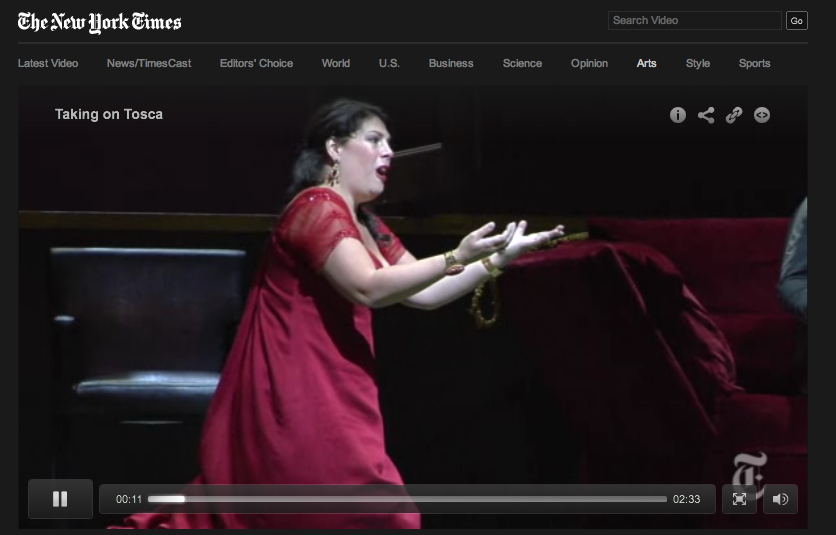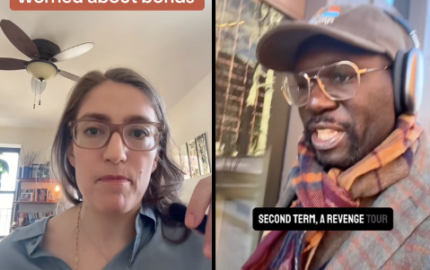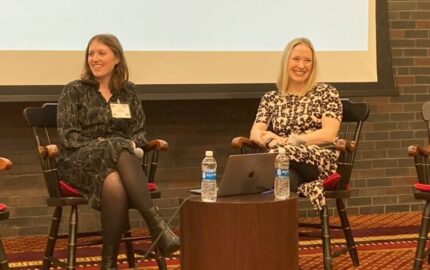I’ve noticed a recent video journalism trend against treating the audience to a bit of narration. Yes, I said narration: the stuff so many video journalists shy from. Why the shyness? I’ve got some theories. More on that in a second.
First, though, before I go casting stones around the glass houses of filmmaking, here’s a short piece I did – a profile of an opera singer – with no narration:
Does it work? Did you get the information that you need? I think so, but it’s low-hanging fruit. Quick profiles like this − a glimpse into a person’s life and work − tend to be fairly straightforward. The stories almost tell themselves, especially if you ask questions that elicit the answers that you need in order to satisfy the who, what, when, where, why and how. (It also doesn’t hurt when you’ve got a subject like Sondra Radvanovsky, who is a performer and delivers short, punchy, info-filled sound bites.)
I see a lot of this style of work online – the New York Times multimedia project “One in 8 Million” used it to great effect; the slick “California is a Place” series rarely has narration beyond text on screen; the YouTube “THNKR” channel does the same with its profiles; and I see a lot of it in the documentary channel on Vimeo. There’s nothing wrong with a narration-free project, but we video folks can become a bit too enamored of our material, and we sometimes lock ourselves into a format for aesthetic reasons, or in fear of writing, largely ignoring a wide audience’s interests or attention span.
When I first started making videos I wanted them to be as rich and sophisticated as the documentaries I thought were really terrific – D.A. Pennebaker's Don’t Look Back, about Bob Dylan’s 1965 tour of Europe; the slice-of-life and culture films of Les Blank; “Crumb,” about the neurotic underground comic book artist R. Crumb, by Terry Zwigoff. I liked these films for what they were as much as for what they weren’t.
They were filmic – scenes rolled into each other, forming a narrative – and unlike TV news there was no stuffy voice of authority telling me what was going on as if I couldn’t figure it out on my own. Blank’s films – from “Garlic is as Good as Ten Mothers” to “The Blues According to Lightin’ Hopkins” and “Always for Pleasure” are fully immersive and offer a rich mix of food, music and culture, with a bit of interview to hold things together. I long thought that building a visual story was best done with just the quotes from interviews and the scenes I’d shot, and that the highest art of making a film or a video happened without narration; it was a feat of mastery, like a woodworker who can make a chair with no metal fasteners.
I also thought my voice sounded lousy, and I didn’t want to intrude on what I thought was the purity of the story, of filmmaking.
Then I started working at a newspaper, alongside reporters who could knock out 1,100-word features in an afternoon. There was no way to match that kind of output considering the laborious process of finding all the right quotes in my footage, or doing the intensive pre-production and back-end editing to make it all work. And in the careful world of explanatory and investigative journalism, un-narrated pieces were out, too. I started to think that maybe my narration-free ways might have to change. I began to use a fair amount of voice-over, sometimes using a reporter’s voice, slowly coaching him through the basics of narration but more often voicing the pieces myself. While I’m no Will Lyman, I once even got a compliment from a viewer who liked that my voice-over didn’t sound like a TV announcer’s.
No text reporter would call what she does narration, but that’s essentially what it is. Read any good newspaper or magazine story and count how much of it is in quotes. Not a lot, right? Most is analysis, the condensing of reported facts, background on laws, observations from a scene and explanations of opposing viewpoints. It’s pretty hard to tell a story that has any controversy without narration and, let’s face it, most good stories contain some strife. Imagine any newspaper story that was as narration-free as some of my favorite films – they’d be a jumbled mess of quotes, and nothing else.
Sure, video or film is its own language that conveys information. A series of shots edited together of fields, silos and dirt roads may let us know that this is a story about the rural Midwest, about farm country, but what if the story is about the effects of the drought on the competing interests of ethanol and beef production? That’s a tough story to get across in just quotes from interviews and pretty shots of cows and corn. On top of that, few of us get the kind of time with a subject to produce verité scenes that move a story along without narration.
This is where we online video journalists need to ratchet up the game. Yes, our stories often appears next to a more in-depth, text-based report, but if given the access and the time to craft a substantial story, shouldn’t our work be able to stand alone and grab viewers in the same way that a traditional TV package might?
For some insight on this I talked to my former professor, Bob Calo, who teaches long-form television at the University of California, Berkeley Graduate School of Journalism. He’s spent much of his career in the broadcast world but keeps an eye on what’s going on online. He’s noticed many of the same structural issues with web video storytelling that I have.
What’s developed online is the slow creep of what he calls “story mesa” over the classic story arc. Instead of grabbing the viewer and keeping the interest up with twists and turns and a denouement, he says, many online videos now start out with something interesting – say, an artisan craftsperson or a glimpse inside a subculture. They go up, and then, like a mesa, they simply flatten and fizzle out with snippets of interview laid under luscious photography.
They’re often videos that simply don’t have a story – they’re a topic, like urban beekeepers or a look inside the world of lowrider car enthusiasts, and overwhelmingly the only voices the audience hears is that of the subject, waxing on about the pleasures of beekeeping or the community of lowriders. Don’t get me wrong, these are fascinating subjects and can make for compelling and even beautiful video but unless there’s some tension – say, a new law that makes it illegal to keep bees near schools – then there’s not going to be much arc or interest beyond people who already care about bees or lowriders.
The problem, Calo says, is that many online video producers and their organizations aren’t thinking the way that old TV hands do, that they’re competing for an audience that feels “hostile indifference.” The audience is ready to click the remote to something zippier, more interesting or maybe to a story with a bit more arc and tension.
He’s right. And one of the key ways to ratchet up that interest is with some narration.
Narration bridges great quotes and most importantly offers an opportunity to lay out a nut graf, to explain why someone watching at home shouldn’t just jam the video player scrubber to the end of the piece or click away to something else.
Narration doesn’t mean you have to sound like Kent Brockman on The Simpsons, or write like him.
There’s a reason that that kind of faux-TV news-speak that we see on satire shows like The Daily Show or at The Onion works, and that’s because the writers there use the forms and formulas of bad TV news writing so well. Good narration is spare, informative and keeps the audience hooked. It’s conversational, not preachy. Avoid puns and cuteness. Just the facts, ma’am. And when it’s used well, it gets you to the next sound bite and makes it sing.
So here’s a challenge to all of you video and multimedia folks. The next time you’re working on a project and you’re thinking it’ll be just voices, try making a cut, even a rough cut, with narration. I know it’ll be extra work, but tell me if it doesn’t improve the story’s clarity and tension, and make the edit a bit faster. If you think I’m out to lunch, let me know and send me examples of your all-natural sound and interview piece. I’d love to hear from you either way.
***
 Sean Patrick Farrell (@spatrickfarrell) is a staff video journalist at the New York Times and writes the Viewfinder column for Storyboard. He last wrote about video journalism projects that work. He has made videos about tracking wolverines in Montana, dangerous medical radiation and aspiring young opera singers, among many others. He is a graduate of the University of California, Berkeley’s Graduate School of Journalism, where he studied documentary film. Before becoming a journalist, he spent a decade working as a bicycle mechanic. You can find more of his work at www.seanpatrickfarrell.com.
Sean Patrick Farrell (@spatrickfarrell) is a staff video journalist at the New York Times and writes the Viewfinder column for Storyboard. He last wrote about video journalism projects that work. He has made videos about tracking wolverines in Montana, dangerous medical radiation and aspiring young opera singers, among many others. He is a graduate of the University of California, Berkeley’s Graduate School of Journalism, where he studied documentary film. Before becoming a journalist, he spent a decade working as a bicycle mechanic. You can find more of his work at www.seanpatrickfarrell.com.



